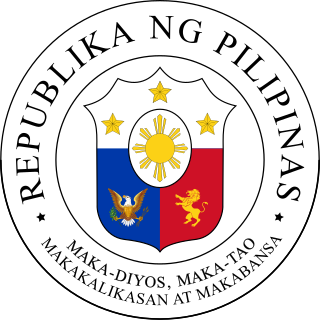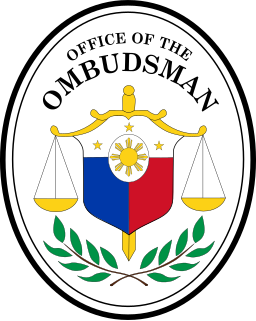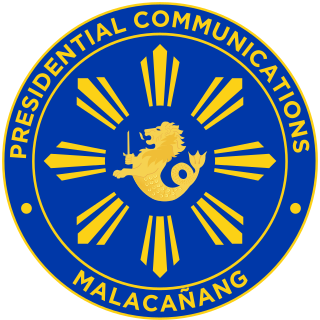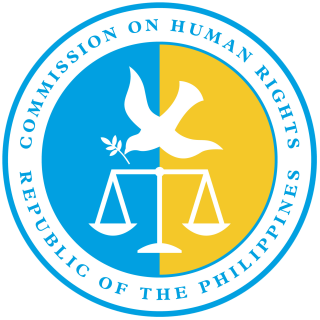
The president of the Philippines is the head of state and the head of government and chief executive of the Philippines. The president leads the executive branch of the Philippine government and is the commander-in-chief of the Armed Forces of the Philippines.

The Cabinet of the Philippines consists of the heads of the largest part of the executive branch of the national government of the Philippines. Currently, it includes the secretaries of 22 executive departments and the heads of other several other minor agencies and offices that are subordinate to the president of the Philippines.

The Ombudsman of the Philippines, also known as Tanodbayan ng Pilipinas, is an ombudsman responsible for investigating and prosecuting Philippine government officials accused of crimes, especially graft and corruption.

The vice president of the Philippines is the second-highest official in the executive branch of the Philippine government. The vice president is directly elected by the people, and is one of only two nationally elected executive officials, the other being the president.

The National Intelligence Coordinating Agency (NICA) is the primary intelligence gathering and analysis arm of the Government of the Philippines in charge of carrying out overt, covert, and clandestine intelligence activities. The NICA cooperates with friendly countries and government agencies in and out of the country by posting agents as liaison officers.

This article covers the history of the current Philippine republican state following the 1986 People Power Revolution, known as the Fifth Philippine Republic.

The Presidential Communications Group, or simply the Communications Group, is the collective name for the offices within the Office of the President of the Philippines and refers to the position of the Office of the Press Secretary, formerly known as the Secretary of the Presidential Communications Operations Office (PCOO). The office of the presidential spokesperson was previously under the Communications Group.

The National Economic and Development Authority is an independent cabinet-level agency of the Philippine government responsible for economic development and planning. It is headed by the president of the Philippines as chairman of the NEDA board, with the Secretary of Socioeconomic Planning as vice-chairman. A number of Cabinet members, the Governor of the Bangko Sentral ng Pilipinas, the Chairperson of the Metropolitan Manila Development Authority, the Chief Minister of Bangsamoro, the Secretary of Information and Communications Technology, the Chairman of the Subic–Clark Area Development Corporation, and the National President of the Union of Local Authorities of the Philippines are members of the NEDA Board.

The Office of the Executive Secretary of the Philippines is the head and highest-ranking official of the Office of the President of the Philippines and a member of the Cabinet of the Philippines. The office-holder has been nicknamed as the "Little President" due to the nature of the position. It was given the mandate "to directly assist the President in the management of affairs of the government as well as to direct the operations of the Executive Office." It is headed by the Executive Secretary.

The Philippines' National Food Authority, is an agency of the Philippine government under the Department of Agriculture responsible for ensuring the food security of the Philippines and the stability of supply and price of rice, the Philippines' staple grain.

The National Youth Commission, also known as the NYC, is a government agency in the Philippines that specifically addresses issues surrounding the Filipino youth. It was founded on June 30, 1995, via Republic Act 8044 or the "Youth in Nation-Building Act of 1995".

The Commission on Human Rights (CHR) is an independent constitutional office created under the 1987 Constitution of the Philippines, with the primary function of investigating all forms of human rights violations involving civil and political rights in the Philippines.

The National Commission on Muslim Filipinos is a government agency in the Philippines, whose objective is to promote the rights of Muslim Filipinos and to make them active participants in Philippine nation-building.

The National Security Council is the principal forum of the president of the Philippines considering national security and foreign policy matters with his senior national security advisors and cabinet officials.

The Office of the President of the Philippines, is an administrative, advisory, and consultative government agency that aids the president of the Philippines in performing their duty as head of state and chief of the executive branch of government.
The following are the events in related to Philippine law in 2016. This includes developments in criminal investigations of national notability.
8888, also known as the Citizens' Complaint Hotline and the President's Hotline, is a 24/7 national public service hotline operated by the government of the Philippines. It was introduced on August 1, 2016, by President Rodrigo Duterte to allow the public to report poor government front-line service delivery and corrupt practices in all government agencies, government-owned and controlled corporations, government financial institutions, and other instrumentalities of the government.
The presidential spokesperson was a government official whose primary responsibility was to serve as the speaking representative of the President of the Philippines. The Press Secretary has historically assumed the role.
The first 100 days of Rodrigo Duterte's presidency began on June 30, 2016, the day Rodrigo Duterte was inaugurated as the 16th president of the Philippines. The concept of the first 100 days of a presidential term was first adopted in the Philippines by President Corazon Aquino from the United States and has since been used as a gauge of presidential success and activism, and is a considered the "honeymoon period" where traditional critics are urged to refrain from detracting the new president. The 100th day of his presidency ended at noon on October 8, 2016.
















